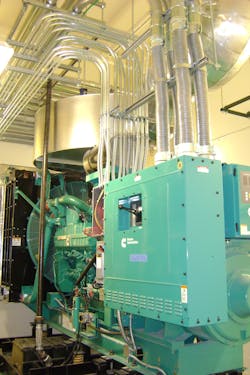For most types of facilities, generators are typically the last line of defense when there is a utility failure or a catastrophic event. Their importance is even more significant in health care, data center, or critical mission facilities. In the past, a typical emergency power system consisted of a single generator and distribution equipment. These days, however, more facilities are rethinking this traditional type of design and realizing the benefit, flexibility, and redundancy opportunities afforded with using multiple smaller generators in parallel to address emergency load requirements.
If the project budget funds are limited, using paralleling generators is an excellent design alternative. Instead of purchasing a standalone “right fit” gen-set, which may not have the capacity for expansion, or oversizing the generator to accommodate both current and future loads, a multiple generator approach is a good choice.
A single generator offers a single point of failure with no redundancy opportunities. Beyond the lack of redundancy issue, we all know the additional problems of using one large generator that is not capable of attaining a 30% load (including, but not limited to, wet stacking), and the requirement of bringing in (or purchasing) a load bank for required testing. In addition to these functional issues, using a single generator may create the stigma of “wasting money” on an overdesigned system — even though the additional capacity will be required in Phase 2 of the project.
By selecting a paralleled system and specifying paralleling gear with bussing suitable for the desired target load, a more cost-efficient and flexible design can be provided for the emergency needs of a facility. Including additional input breakers for future generators or specifying an extended buss to be able to add an additional section or breaker(s) will also increase the flexibility and add value to the design.
There are a lot more benefits when using a paralleled design. Multiple small generators are assured to meet the 30% loading criteria. Multiple generators can also decrease the run time hours for each generator. For a non-catastrophic power failure lasting a short duration, the emergency distribution system will probably not see the full demand load. Often in these scenarios, one of the multiple generators is not required to support the outage. If the event is a longer duration, additional loads will be shifted onto the emergency infrastructure (picture a hospital in the middle of the day on a Wednesday when all the loads are now plugged in to the “red” outlet and it’s the hottest day of the year) as needed. An extended outage load may then warrant the additional gen-set(s) to be added to the buss to provide extra capacity. There is also the option to provide N+1 redundancy for the emergency systems design. In this scenario, one generator can be taken off line for scheduled maintenance without jeopardizing the emergency system design capacity. Along with allowing redundancy for the system, additional spare breakers can be furnished for a “shore power” portable generator connection.
With all of the benefits of a paralleled system, there are a few things to be mindful of when implementing a paralleled design, whether it is implemented in phases or includes a shore power alternative. Not all generators play nice together. Some manufacturers have the paralleling “intelligence” within the generator itself while others depend on all of the programming to be located in the paralleling gear. Capacity and ability to program and install the generators, use the existing breakers, and landing the cables should also be thought through when designing a paralleling system. Then, there is the topic of the pitch.
No, generators don’t sing (yes, they do hum but that point is irrelevant.). The winding pitch of a generator is a calculated ratio of the generator’s coil span divided by the pole pitch (mechanical space between adjacent poles). Typically, you see the pitch of a generator to be 2/3. But this is not always the case. The winding pitch for a generator can differ between manufacturers and generator type. When the characteristics of the generators are not the same, it is difficult to synchronize the generators to be able to automatically and systematically add them to the buss. Again, having dissimilar parameters is not a game stopper but it does make the paralleling process significantly more difficult, laborious, and time consuming — and should be taken into consideration when implementing a phased or shore power paralleling design.
Implementing a paralleled multiple generator system design allows a phased building block approach. Not only is this a budget-responsible method of design for future proofing an installation but it also provides additional system security with redundant pieces of equipment. When one of the multiple generators is out of commission, there are still other sources available to maintain emergency power. This eliminates the dependence on one single source of power. The paralleling philosophy should also be taken into consideration when no facility expansion is anticipated.
About the Author
Krista McDonald Biason, P.E.
Associate Vice President
Krista McDonald Biason, P.E., is the national electrical practice leader at HGA Architects and Engineers in Minneapolis, where she specializes in electrical infrastructure planning and design for health care, commercial and community projects. She is a member of ASHE (American Society for Healthcare Engineering), and serves on the NFPA (National Fire Protection Association) 70 National Technical Committee-Code-Making Panel 13, which develops NEC (National Electrical Code) articles pertaining to emergency power systems.
